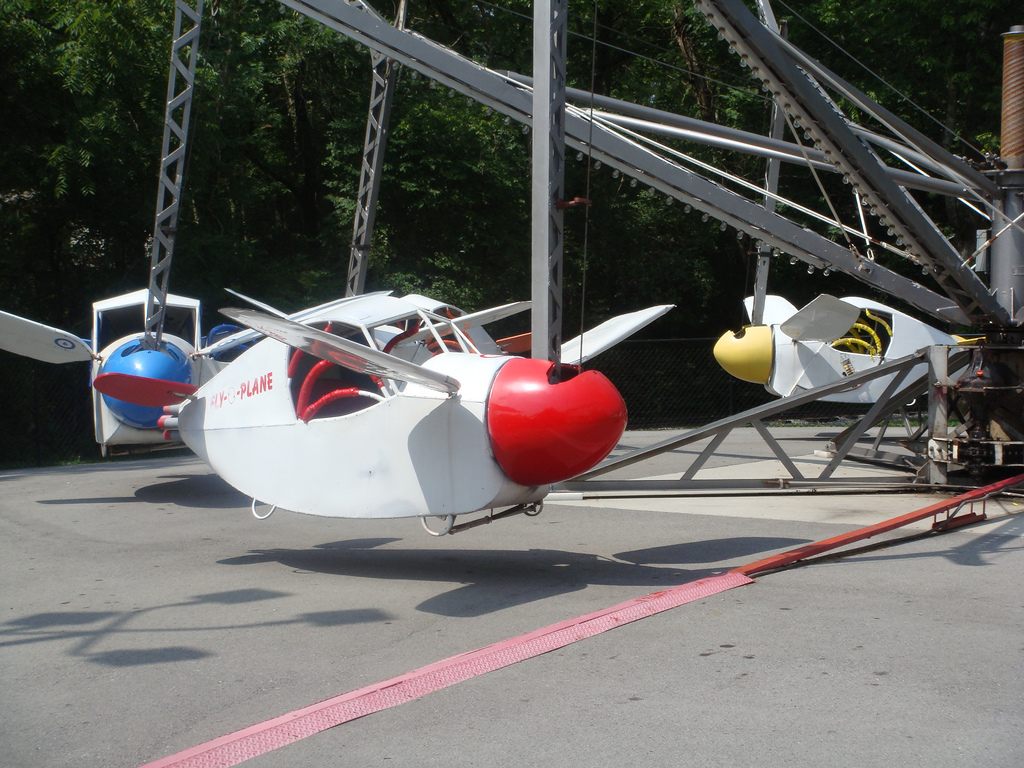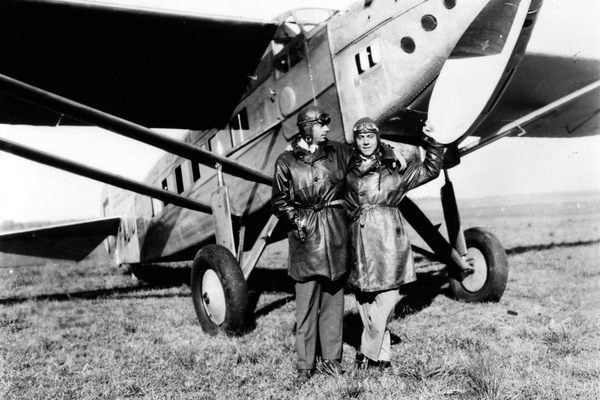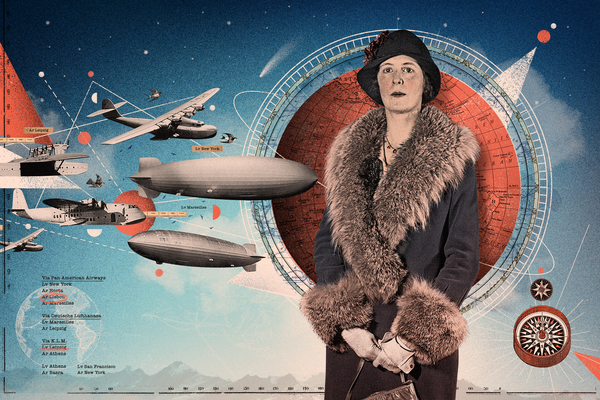Classic Carnival Rides Are Flight Simulators in Disguise
That’s what their inventor Lee Eyerly intended them to be, anyway.

The very rare Fly-O-Plane. (Photo: Martin Lewison/CC BY-SA 2.0)
Lee Eyerly wasn’t trying to give anyone a thrill. The inventor was trying to help people learn how to fly. The flight simulator he built at the beginning of the 1930s was a small plane that could loop, turn and roll while suspended in the prongs of a giant, Y-shaped fork.
Eyerly used it to train would-be pilots, until some clever person (it may have been a fellow aeronautic enthusiast, or a passing salesman, but no one knows for sure) suggested a different use. Why not let anyone on, for a price?
It was a hit, and orders from the operators of fairs and carnivals started rushing in. The contraption, which would be re-named the Acroplane, became a thrill ride—the first of a series of iconic Eyerly-created rides. His Loop-O-Plane, his Roll-O-Plane, his Spider, his Fly-O-Plane, and his Rock-O-Plane gave people a taste of what it was like to fly, at a time when aviation was just taking off. In an Eyerly ride, you would go up and down and upside down. Your stomach would sink, and your body would panic and thrill.
“When these rides were invented, roller coasters were made out of wood, they didn’t go upside down, they were only 50 or 60 feet tall,” says Tim Baldwin, the communications director of American Coaster Enthusiasts, the “world’s largest ride enthusiast organization.”
Some of these rides still linger in American amusement parks, where they’re both more jarring and more tame than modern monster coasts. But in the ‘30s and ‘40s, Eyerly rides and their ilk “were the thrill rides,” Baldwin says. “They were the ones that tested your courage and your bravery.”
Eyerly was good with all kinds of machines—he built and raced cars, too—but he couldn’t keep away from planes. In 1911, when he was 19, he traveled to the second major airshow in the United States, at Dominiquez Field, in California, where fledgling aviators competed for records in speed, flight length and skill. In the next few years, still living in Montana, he built his first plane, even though he didn’t have an engine to power it.
Eyerly officially learned to fly, with three hours of instruction, in 1920, but it took him a few more years to make flying his profession. In Salem, Oregon, he bought his first plane in 1926 and lobbied the city to open an airport. By the end of the decade, he had opened his own flying school, where he created the Acroplane. When he found how profitable it could be as a thrill ride, he started designing machines that were meant to be pure fun and thrills. In a few years, he invented a series of classic carnival rides.
His first, the Loop-O-Plane, had two arms that swing back and forth until they’re looping in circles, taking riders upside down.
The Roll-O-Plane, which came in 1934, had just one arm, with a capsule on either end, and added a rolling motion to the basic loop.
The Octopus, from 1935, had eight arms that lifted riders up and quickly dropped them down, while they spun and spun and spun.
In the many-armed Fly-O-Plane, riders could roll around in their own capsule. It’s hard work to keep upright.
The last Eyerly O-Plane ride, the Rock-O-Plane was gentler. It looked almost like a Ferris Wheel, only riders sat in cages that they could rotate and hang upside-down while the giant wheel spun on its axis.
The Octopus was one of the most popular rides and spawned two generations of offspring, the Spider and the Monster. It’s also the ride that ultimately ended the company Eyerly founded.
For two generations after Lee Eyerly first started making these machines, the Eyerly Aircraft Co. outfitted amusement parks with rides, until 1985. The company shut down entirely in 1990, after a lawsuit over a death on a Monster bankrupted the company.
In 2008, Jon Eyerly, Lee’s grandson and the last president of the company, told the Salem Statesman Journal that “at least a thousand, for sure, are left and running.” But they’re increasingly hard to find. Some of these rides may still move around the country with traveling carnivals: one of the advantages of Eyerly’s inventions was that they each could be packed and transported in a single truck. But when I asked the American Coaster Enthusiasts where to go to find these rides, they came up with a fairly short list.
The Rock-O-Plane might be the easiest to find. Santa Cruz Beach Boardwalk and Lagoon, in Farmington, Utah, both have one. The Arnolds Park Amusement Park in Arnolds Park, Iowa, has a Rock-O-Plane and a Roll-O-Plane. Oak’s Park in Portland, Oregon, has a Rock-O-Plane and a Spider. Joyland, in Lubbock, Texas, has a Rock-O-Plane and a Roll-O-Plane.
Much more rare is the Fly-O-Plane, by reputation the most aggressive and uncomfortable of these rides. The only place the ride enthusiasts could think of to experience its maniacal spin and the hard work of keeping yourself upright on the ride is the Lake Winnie Amusement Park in Georgia.
The only Loop-O-Plane they could think of was at Lakeside Amusement Park, in Denver, Colorado. Lakeside also has a Rock-O-Plane, a Roll-O-Plane, and a Spider—this may be the best chance for the fullest Eyerly experience of flying through the air and imagining what it was like for early aviators.









Follow us on Twitter to get the latest on the world's hidden wonders.
Like us on Facebook to get the latest on the world's hidden wonders.
Follow us on Twitter Like us on Facebook